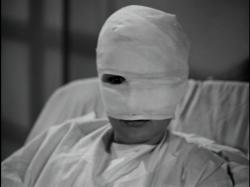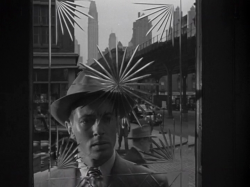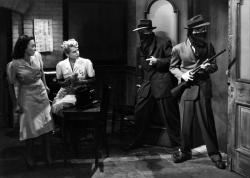Reviews
Anthony Mann
USA, 1946
Credits
Review by Victoria Large
Posted on 23 January 2013
Source Kino International DVD
Categories Noir Mann
Director Anthony Mann’s relatively obscure noir, Strange Impersonation, has a premise that’s at once outrageous and hooky: Nora Goodrich, a gifted research scientist, is disfigured in a lab accident engineered by her jealous assistant, Arline, who has designs on Nora’s fiancé Steven. Nora subsequently fakes her own death, undergoes radical plastic surgery, and sets out to uncover the truth about what happened to her. The film may not be realistic, but it is awfully watchable: we’re talking melodrama so high that it often feels surreal, clipping along at a brisk sixty-eight minute running time.
In his essay “Mann in the Dark: the Films Noir of Anthony Mann,” critic Robert E. Smith expresses little admiration for the “overstated and coincidence-prone material,” described above, but he nevertheless acknowledges that Strange Impersonation “points the way to what would be Mann’s forte during this period: a nightmare landscape of pain, trapped characters, and vicious, unscrupulous villains.” And indeed, though the film telegraphs many of its punches (including its final twist), Arline’s rapidly escalating treachery and Nora’s own willingness to go to wild extremes do much to create the kind of “nightmare landscape” that Smith describes. Adding to the nightmarishness is Steven’s gullibility and general uselessness. (Supposedly an accomplished scientist, he causes an accidental explosion almost immediately upon entering Nora’s laboratory in one of his first scenes.) While one could argue that the characters are too broadly drawn, that broadness also intensifies the potent through-the-looking-glass quality that permeates the film.
Strange Impersonation is a low budget affair from the independent Republic Pictures, but Mann is able to create bits of striking imagery, some of which seems to anticipate the noir-inflected fantasias of films like Tim Burton’s Batman or Sam Raimi’s Darkman. A flashing neon sign lights a cheap apartment. Arline’s dark silhouette appears like a blot. A bandaged Nora peers out at the world from the single eyehole. Perhaps most memorable is the film’s grim, groggy interrogation sequence, which finds Nora under a blinding white light, trapped in too-close close-ups while people tower over her. The scene builds to a queasy crescendo as images and voices begin to overlap. There’s undoubtedly a touch of nostalgia in my fondness for all of this, but it’s fun just the same.
Indeed, Strange Impersonation is easy to get a kick out of, especially when we encounter its wonderfully odd side characters. That includes H.B. Warner (who also played Mr. Gower in It’s a Wonderful Life) as the plastic surgeon who tells Nora, “You can change your face — with clever surgery you can change your face completely — but you cannot change yourself. You cannot escape the person you are,” and character actress Mary Treen as an oppressively optimistic nurse who refers to her patients as “we.” (As in, “It gets awfully tiresome when we’re all alone in the dark.”) The film is unapologetically weird, and more interesting for it.
Yet while time has been kind to the film’s occasional visual flourishes and notable character turns, its assumptions about gender are nothing if not creaky. For instance: when Steven asserts that Nora would have stood by him had he been the one who was disfigured, Nora insists that, “it wouldn’t have been the same thing at all,” and much of the conflict in the story stems from Nora’s refusal to put her marriage to Steven ahead of her (apparently groundbreaking and valuable) scientific research. Steven may be little more than a dupe, but he’s also the prize that Nora and Arline are vying for, and the film is not radical enough to question that, or Arline’s assertion that “money, security, and comfort” are “everything a woman wants.”
Strange Impersonation is both stylistically and ideologically of its time, and that serves as both a recommendation and something of an apology. The ending is at once predictable and conservative, but there’s a great deal of loopy enjoyment to be had along the way.
More Noir Mann
-

Strangers in the Night
1944 -

Strange Impersonation
1946 -

He Walked By Night
1948 -

The Great Flamarion
1945 -

Border Incident
1949 -

Side Street
1950 -

Railroaded
1947
We don’t do comments anymore, but you may contact us here or find us on Twitter or Facebook.



